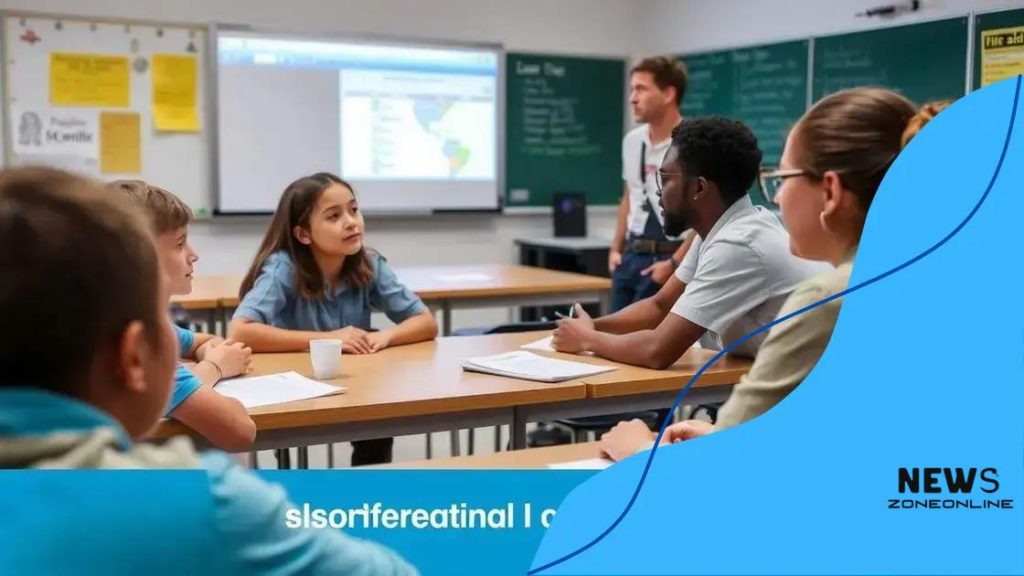Limits on classroom data monitoring: what you need to know

Limits on classroom data monitoring are essential to protect student privacy while utilizing data effectively to enhance learning outcomes and ensure compliance with legal and ethical standards.
Limits on classroom data monitoring have become a hot topic in educational discussions. With technology evolving, it’s essential to consider how monitoring affects student privacy and learning environments.
Understanding classroom data monitoring
Understanding classroom data monitoring is crucial in today’s educational landscape. As technology becomes more integrated into learning, teachers and administrators can track students’ progress more effectively. This aspect of education can enhance learning outcomes but raises important questions about privacy and ethics.
The Role of Technology in Data Monitoring
In many classrooms, technology is not just a tool but a comprehensive system for tracking students’ performance. Information such as test scores, attendance, and even behavior can all be monitored. With this data, educators can tailor their teaching to meet each student’s unique needs.
- Improving student engagement through real-time feedback
- Identifying students who may need additional help
- Enhancing overall classroom management
However, this capability also requires careful consideration. As we collect and analyze data, it is essential to ensure that student privacy is prioritized. Maintaining secure data practices not only builds trust but also complies with legal requirements regarding student information protection.
Ethical Considerations in Data Usage
Teachers must navigate the fine line between utilizing data to improve education and respecting students’ rights to privacy. An open dialogue with students and parents can demystify data monitoring. Educating them on what data is collected and how it is used can alleviate concerns.
- Transparent communication with stakeholders
- Implementing data protection policies
- Regularly reviewing data usage practices
Ultimately, understanding classroom data monitoring involves recognizing its potential benefits while actively addressing the ethical implications. By balancing these two factors, educational institutions can make informed decisions that foster a supportive learning environment.
Legal frameworks governing data monitoring
Legal frameworks governing data monitoring are essential for protecting student privacy while utilizing educational technology. Various laws shape how data can be collected, stored, and used in schools. Understanding these regulations helps educators navigate the complex landscape of data use.
Key Regulations in Educational Data Monitoring
Several important laws guide schools in managing student data. For example, the Family Educational Rights and Privacy Act (FERPA) grants parents rights over their children’s education records. Knowing these rights is vital for both educators and parents.
- FERPA protects student education records.
- The Children’s Online Privacy Protection Act (COPPA) regulates data from children under 13.
- The Health Insurance Portability and Accountability Act (HIPAA) can apply in some educational settings.
These regulations ensure that schools handle data responsibly. Compliance is not just about avoiding penalties; it’s also about building trust with students and parents. Schools must be transparent about their data practices.
Impact of State Laws on Data Monitoring
In addition to federal laws, many states have their own regulations regarding data monitoring. These laws can vary significantly. For instance, some states have enacted policies that require explicit consent from parents before collecting data.
- State laws may enhance privacy protections.
- They can also impose stricter rules on data sharing.
- Schools must stay updated on changing laws to remain compliant.
As technology evolves, educational institutions should regularly review their data monitoring policies. This ensures adherence to both federal and state regulations, allowing for effective data use while safeguarding student rights.
Impact on student privacy rights

Impact on student privacy rights is a critical issue in today’s educational system. As data monitoring becomes more common, understanding how it affects students is essential. Ensuring that students’ personal information remains protected while benefiting from data-driven insights is a balancing act for schools.
Understanding Student Privacy
Every student has the right to privacy, and this extends to their educational records and personal data. Schools collect various data points, from academic performance to behavioral analytics. With this data collection, concerns about misuse arise.
- Students may feel uncomfortable knowing they are being constantly monitored.
- The risk of data breaches could expose sensitive information.
- Parental concerns are increasing regarding the safety of their children’s data.
It’s important for schools to communicate how they use data and what safeguards are in place to protect students. Maintaining transparency helps build trust within the school community.
Legal Protections for Student Data
Legal frameworks, such as FERPA and COPPA, set standards for how schools must handle student data. These laws provide essential protections, but they also require schools to be proactive in implementing strict data management practices. Institutions must educate staff about these laws to ensure compliance.
- FERPA allows parents and eligible students to access educational records.
- COPPA restricts the collection of personal information from children under 13.
- Non-compliance can result in severe penalties for schools.
By adhering to these regulations, schools can mitigate privacy risks and foster a secure learning environment for all students. This commitment to protecting student privacy is vital as technology continues to evolve.
Best practices for data protection in classrooms
Best practices for data protection in classrooms are essential for ensuring that student information remains secure in an increasingly digital learning environment. As educational institutions adopt various technologies, it’s crucial to implement effective strategies to protect sensitive data.
Establish Clear Data Policies
Creating and enforcing clear data policies is a foundational step for schools. These policies should outline how data is collected, used, and shared. Educators need to understand their responsibilities regarding data management.
- Define what types of data will be collected.
- Specify how data will be stored and protected.
- Communicate policies to staff, students, and parents.
Having a robust policy in place builds transparency and trust within the school community. It also helps ensure compliance with legal regulations regarding data privacy.
Implement Strong Security Measures
Physical and digital security measures are crucial in protecting student data. Schools should conduct regular assessments of their security practices to identify vulnerabilities. This includes safeguarding both hardware and software used for data management.
- Use encryption to protect sensitive information.
- Implement access controls to restrict data access to authorized personnel only.
- Regularly update software to address potential security threats.
Investing in security training for staff is equally important. Educators should be equipped to recognize potential threats, such as phishing attacks, and understand how to respond effectively.
Foster a Culture of Privacy Awareness
Encouraging a culture of privacy awareness among students and staff can empower everyone to take part in protecting data. Schools can hold workshops and training sessions focused on data privacy. Engaging students in discussions about their rights and responsibilities related to data will help them understand the importance of protecting their information.
- Promote good digital citizenship practices.
- Teach students how to manage their online presence.
- Encourage reporting of any suspicious activity.
By following these best practices, schools can create a secure learning environment that respects and protects student privacy while leveraging the benefits of data monitoring.
Future trends in educational data monitoring
Future trends in educational data monitoring are shaping the way schools use technology to enhance learning experiences. As data collection methods improve, new opportunities and challenges will arise for educators and students alike. Staying informed about these trends is crucial for effective data management in the classroom.
Increased Use of Artificial Intelligence
Artificial intelligence (AI) is becoming an integral part of educational data monitoring. Tools powered by AI can analyze vast amounts of data, providing insights that help educators tailor instruction to individual student needs.
- AI can identify learning patterns and challenges.
- It aids in predicting student performance and outcomes.
- Customized learning paths can be developed based on data analysis.
As AI continues to evolve, its implementation in schools will likely lead to more personalized learning experiences, potentially raising engagement levels among students.
Focus on Data Ethics and Privacy
With the growing use of data, there will be an increased focus on ethical considerations and student privacy. Schools must ensure they use data responsibly while complying with legal protections.
- Training staff on ethical data use will be essential.
- Policies about data sharing and consent will likely become stricter.
- Parents and students will demand greater transparency regarding data practices.
Institutions that prioritize ethical practices will foster trust and encourage open communication about data monitoring.
Integration of Learning Analytics
Learning analytics is another key trend that will shape the future of educational data monitoring. Schools can utilize data not only to track performance but also to enhance teaching strategies.
- Real-time feedback helps improve teaching methods.
- Data can inform curriculum development based on student success.
- Collaboration between teachers and data analysts will become more common.
As learning analytics toolsets become more sophisticated, they will play a vital role in driving educational success, helping educators make informed decisions that positively impact student learning.
FAQ – Frequently Asked Questions About Data Monitoring in Education
What is educational data monitoring?
Educational data monitoring involves tracking student performance and behavior using technology to improve learning outcomes.
How does AI influence data monitoring in classrooms?
AI helps analyze large amounts of data, providing insights that allow educators to tailor instruction to individual student needs.
What are the privacy concerns associated with data monitoring?
Privacy concerns include the risk of data breaches and the potential misuse of personal information collected from students.
What are best practices for protecting student data?
Best practices include implementing strong security measures, establishing clear data policies, and fostering a culture of privacy awareness among staff and students.





